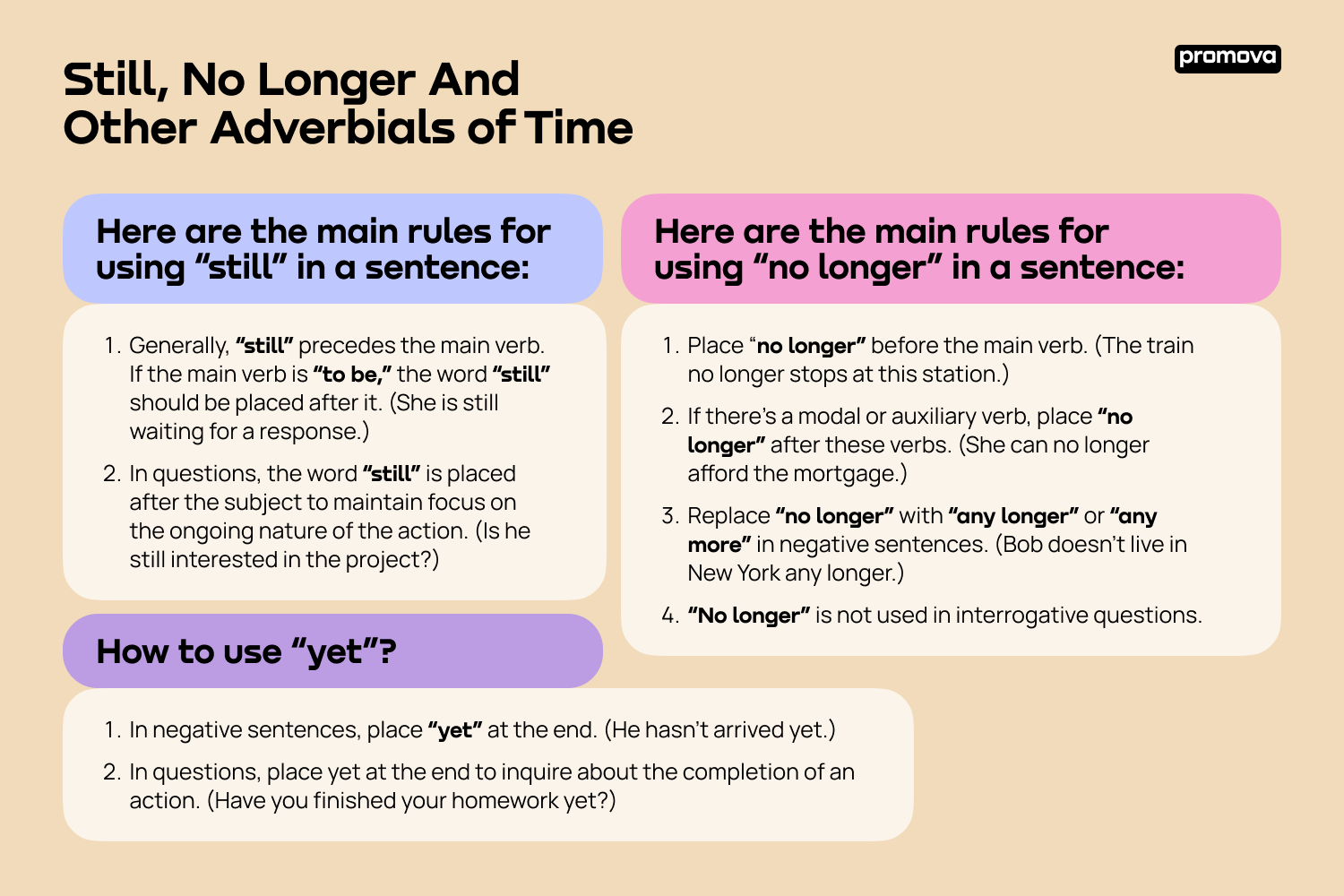Still, No Longer And Other Adverbials of Time
Contents
Adverbials of time such as “still,” “no longer,” “already,” and “yet” are important in the English language, offering deeper communication opportunities. Mastering their use not only enhances fluency but also elevates the precision of your messages. In this article, you will learn the meanings, rules, common mistakes, and practical tips for employing these adverbials effectively.
Still
The adverb 'still' indicates that an action or state started in the past, continues up to the present moment. It underscores the idea of persistence, emphasizing that despite the passage of time, the situation remains unchanged. 'Still' is particularly effective when the continuation extends beyond typical durations. It helps to communicate a sense of ongoing endurance. Here are the main rules for using “still” in a sentence:
- Generally, “still” precedes the main verb. If the main verb is “to be,” the word “still” should be placed after it. (She is still waiting for a response.)
- In questions, the word “still” is placed after the subject to maintain focus on the ongoing nature of the action. (Is he still interested in the project?)
One of the most frequent mistakes is misplacing “still” and putting it at the end of a sentence. In some contexts, it’s stylistically acceptable. However, it spoils the clarity of communication. One more mistake is confusing “still” with “yet” and “already.” These two words serve other purposes in the English language.
“Still', is particularly useful in narratives or explanations where the durability or unchanging nature of a situation is surprising or noteworthy. Use 'still' to emphasize that despite potential obstacles, changes, or the simple passage of time, the core situation remains unchanged, conveying a powerful sense of ongoing presence or activity.
No longer
“No longer” conveys the termination of an action that was once true or ongoing. It marks a clear temporal boundary and is pivotal for indicating change, signaling that a previous condition has ended. It's particularly useful in contexts focusing on transition or discontinuation. Here are the main rules for using “no longer” in a sentence:
- Place “no longer” before the main verb. (The train no longer stops at this station.)
- If there’s a modal or auxiliary verb, place “no longer” after these verbs. (She can no longer afford the mortgage.)
- Replace “no longer” with “any longer” or “any more” in negative sentences. (Bob doesn’t live in New York any longer.)
- “No longer” is not used in interrogative questions.
Very common mistake is using “no longer” to speak about future cessations instead of indicating a completed action. Remember that “no longer” should be used retrospectively.
5
Already
“Already” is an adverb of time that suggests something has occurred before the moment of speaking. This adverb is particularly useful for emphasizing the completed actions. To use “already” correctly, you have to follow these rules:
- Place before the main verb, but after auxiliary verbs like “have,” “has,” “had,” and modal verbs like “can,” or “will.” (She has already finished her homework.)
- In questions, “already” is placed after the subject and before the main verb. (Have you already eaten?)
- Commonly used in perfect tenses.
One of the most common mistakes is confusing “already” with “yet” and “still.” As it was said, “still” is used to communicate about the continuation of an action. “Yet” is used in negative contexts. To use “already” correctly, add it only when you want to emphasize the completed action.
Yet
“Yet” is an adverbial of time used for speaking about an action or state that has not occurred up to the present moment. It implies that while something is anticipated or considered likely, it has not happened as of now. How to use “yet”?
- In negative sentences, place “yet” at the end. (He hasn't arrived yet.)
- In questions, place yet at the end to inquire about the completion of an action. (Have you finished your homework yet?)
There is a nuance when “yet” is used in affirmative sentences. In such cases, instead of being an adverbial of time, it works as a conjunction to show the contrast. It’s very similar to “however” and should be placed at the beginning of the sentence or a clause. For example, “The street was empty, yet wasn’t scared.”

Conclusion
Mastering the use of adverbials “still,” “no longer,” “already,” and “yet” can significantly enhance your command of English. These adverbials offer subtle but powerful ways to convey timing and expectation, crucial for effective communication. By understanding their nuances, avoiding common pitfalls, and applying practical usage tips, you can elevate your linguistic precision and expressiveness.



Comments